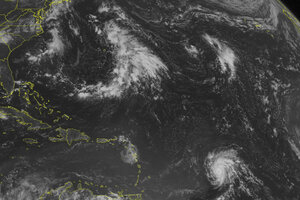As Danny sputters out, tropical storm Erika gathers steam
Tropical storm Erika, the fifth named storm of the 2015 Atlantic Hurricane Season, is forecast to make landfall on the Leeward Islands sometime Wednesday night or Thursday morning.

This NOAA satellite image taken Friday at 9:45 a.m. Eastern time, shows then-category 3 Hurricane Danny to the east of the Lesser Antilles Islands. Danny has since been downgraded to a tropical storm.
Weather Underground/AP
As hurricane Danny diminishes, tropical storm Erika is predicted to gain strength as it approaches the Leeward Islands from the Atlantic, with potential to bring rain to drought-stricken Puerto Rico and the Virgin Islands.
Centered about 730 miles east of the Leeward Islands, Erika is moving west at close to 20 mph, with maximum sustained winds clocked at 45 mph on Tuesday.
Tropical storm watches have been issued for portions of the Leeward Islands including Montserrat, Antigua, Barbuda, St. Kitts and Nevis, Anguilla, Saba, St. Eustatius, St. Maarten, Guadeloupe, St. Martin, and St. Barthélemy. A tropical storm watch means tropical storm conditions are possible within 48 hours.
Erika is the fifth named storm of the 2015 Atlantic Hurricane Season, according to the US National Hurricane Center, which is forecasting the storm to approach the Leeward Islands Wednesday night into early Thursday.
Preceding Erika, Danny weakened to a tropical depression as it moved over the southern Leeward Islands, with the storm's maximum sustained winds decreasing to near 35 mph.
The US National Hurricane Center says Danny is expected to continue weakening and that it will not issue any more advisories on the storm.
This Atlantic hurricane season is projected to be tamer than most, with El Niño in full force – a pattern that is characterized by a shift in wind that causes warmer-than-usual ocean waters in the Pacific, affecting weather patterns around the world, and quieting the factors that foster hurricanes in the Atlantic. The current El Niño is the second strongest on record, according to federal meteorologists.
This report includes material from the Associated Press and Reuters.

